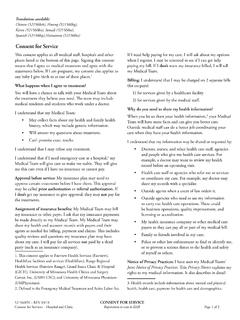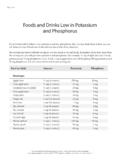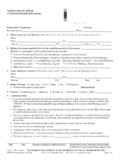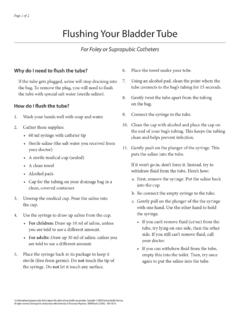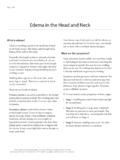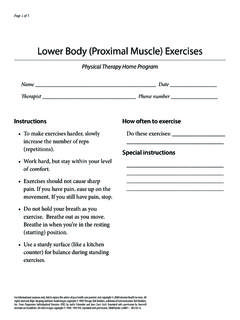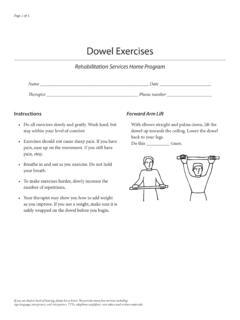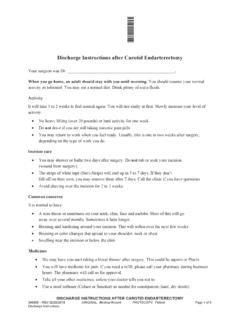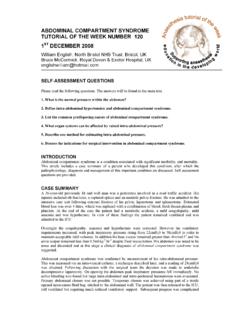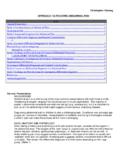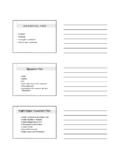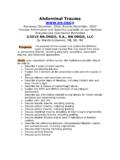Transcription of Abdominal Precautions - fvfiles.com
1 Page 1 of 4 Abdominal PrecautionsProtecting Your Incision While You HealAfter surgery in your stomach or belly area, you must protect your incision (the surgery wound). This will help you heal faster and prevent guidelinesFor at least 6 weeks after your surgery, there are two things you must avoid. Do not lift more than 10 pounds. Avoid heavy pushing or pulling. Take care when pushing with your arms to stand up. Do not strain your belly area. When you bend, sit up or twist, you could strain the area around your incision.
2 Your therapist will show you how to move follow your doctor s directions. If you have questions, call your you are deaf or hard of hearing, please let us know. We provide many free services including sign language interpreters, oral interpreters, TTYs, telephone amplifiers, note takers and written 2 of 4 Moving your bodyMoving in bed When lying in bed, do not sit straight up. If you need to roll in bed, roll like a log: Keep your hips and shoulders in line as you roll. Do not twist your body. To change positions, use your legs to bridge.
3 Lie on your back and bend your knees. Bring your feet toward your hips with your feet flat on the bed. Use leg strength to lift your hips up off the bed. Do this to move toward the head or foot of the bed or to shift right or out of bedDo not sit straight up or twist. Log roll to your side. Bring your heels to the edge of the bed. Start to move your feet off the bed. Push up lightly with your elbow and move to into bed Sitting on the edge of the bed, gently lower yourself to your side and bring your feet onto the bed.
4 Log roll from your side to your up Use leg strength to scoot to the edge of the bed or chair. Place your feet shoulder width apart. Put your hands lightly on your knees, the bed or chair for balance, and use your leg strength to stand 3 of 4 Self careBathing Follow your doctor s directions for bathing and showering. In general, do not take baths until your stitches or staples have been out for 48 hours. When you are allowed to shower, avoid direct spray on your incision. Clean the area by patting it. Do not rub.
5 Getting out of a tub may strain your stomach. To avoid strain, shower or use a bath chair. Do not strain to wash your lower legs and feet. A sponge with a long handle can Do not wear clothes that rub on your incision. Wear sweat pants, clothes with an elastic waist or a loose dress. Avoid jeans or belts. Trying to reach your legs or feet can strain your stomach or rub on your incision. Your therapist can show you ways to dress your lower body while avoiding strain. Equipment like a reacher, sock aid or long shoe horn can may do light exercise and household tasks as long as you avoid strain.
6 Do not lift more than 10 pounds. A gallon of milk weighs about 8 pounds. A bag of groceries weighs 10 to 12 pounds. A full laundry basket weighs up to 25 pounds. Stop any activities that cause strain or pain in your incision area. Your energy level may be low when you first return home. Take rest breaks often and shorten activities if needed. When you are with children or pets, stay within lifting restrictions. You may need to plan for help. Let children know that they must be gentle. Modify activities, for example: Have children climb into your lap instead of lifting them.
7 Use a stroller instead of carrying a child. Find the best way to position a child for feeding, changing and so on. Check with your doctor before you return to work, especially if your job is very physical or requires lifting. The time to return to sex will vary. Consider how well you are healing, your energy level and comfort. Talk to your 4 of 4 DrivingAsk your doctor when you may drive. Most people can start driving after they stop their pain medicine and feel strong enough. Organ transplant patients cannot drive for two weeks after surgery.
8 Some medicines will affect your vision. Make sure you can read traffic signs and see after dark before you drive. You should wear a seat belt unless your doctor tells you not informational purposes only. Not to replace the advice of your health care provider. Copyright 2011 Fairview Health Services. All rights reserved. Artwork 1995 by VHI. Used with permission. SMART works 521159 05/13.

